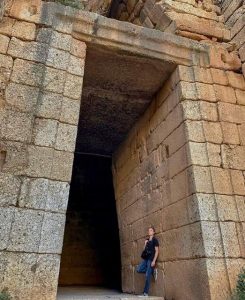In the ancient city of Mycenae, Greece, the Treasury of Atreus stands as a testament to the architectural and artistic prowess of the Mycenaean civilization. Often referred to as the Tomb of Agamemnon, this monumental structure dates back to between 1300 and 1250 BC, serving as a striking example of the advanced engineering skills of its time.
Architectural Marvel of the Mycenaean Era
The Treasury of Atreus, also known as a “tholos” tomb, is characterized by its distinctive beehive shape. Constructed during the height of the Mycenaean civilization, it was built to serve as a burial site for the elite. The tomb’s grandiose design is an engineering marvel, noted for its massive dome which is one of the largest in the world for such a structure and was the tallest and widest dome in the world for over a thousand years.
Design and Structure
The Treasury of Atreus consists of two main parts: the dromos (entry passage) and the tholos (main chamber). The dromos, pictured in the upper part of the image, is a long and narrow walkway lined by large stone walls that lead up to the tomb’s entrance. This walkway sets a dramatic approach to the tomb, enhancing its grandeur and the impression of entering a significant monument.

Inside, the tholos features a perfectly constructed dome made from precisely cut stones that form a corbelled arch. This architectural technique was revolutionary for its time and is highlighted in the lower part of the image, showing the intricate stonework that has stood the test of time.
Historical Significance
Though popularly known as the Tomb of Agamemnon, modern archaeologists believe that it might not actually be the burial place of the famed Mycenaean king who led the Greeks in the Trojan War. However, the association with Agamemnon has persisted, primarily due to the tomb’s majestic appearance and its significance in Mycenaean royalty. The tomb represents the zenith of Mycenaean tomb construction and provides deep insights into the beliefs, rituals, and architectural advancements of ancient Greece.
Archaeological Discoveries
The Treasury of Atreus has yielded various artifacts that offer insights into the funerary practices and material culture of the Mycenaeans. These include pottery, gold jewelry, and tools, which suggest that the tomb was intended for an individual of high status, underscoring the social and political complexities of Mycenaean society.
The Treasury of Atreus or the Tomb of Agamemnon in Mycenae is more than just an ancient structure; it is a masterpiece of archaeological significance that continues to fascinate historians, architects, and tourists. Its construction not only demonstrates the technical abilities of the Mycenaeans but also reflects the importance of death and the afterlife in ancient Greek culture. As it stands, the tomb remains one of the most impressive monuments of prehistoric Greece, offering a window into the past and the enduring legacy of the Mycenaean civilization.








